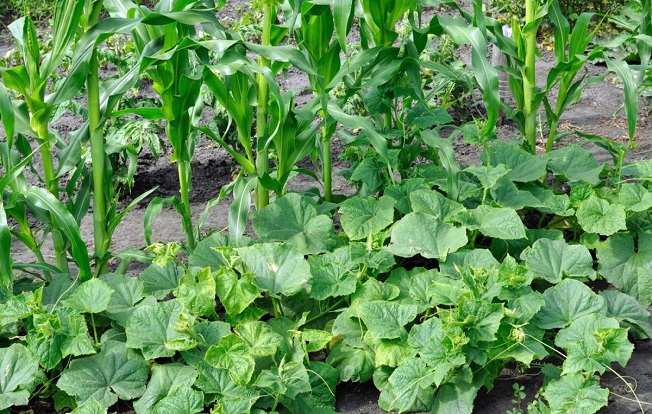
When you observe common combinations in regional food communities, you will notice parallels between what grows well together and what is eaten together in particular areas. History demonstrates a tradition of these combinations, and in some cases, science provides further witness to their usefulness. One such combination, historically indigenous to Central American cultures, but adopted by people in the southwest to southeast North America, is called Three Sisters.
Companion planting, which becomes companion cooking, is a common practice throughout the world. Three Sisters is the companion planting of corn, beans, and squash. Tepary beans have commonly been planted; both are drought-resistant beans like pintos. Any shell or drying bean type will do well in this planting. The corn at the time when Three Sisters came to the modern-day United States was by most estimates, like popcorn or flint corn types. Squash varieties for this planting can include summer squash, and butternut or Hubbard types.
Plant the seeds in small hills, three to six feet apart, with about six seeds to a hill. Once the seedlings emerge and have grown a couple of inches, thin them down to the most vigorous three or four plants. As they grow, climbing beans will twirl up the corn stalks, as will squash. Neither should get high enough to shade the other plants too much.
Three Sisters planting came from Mexico, and spread to the US, where the productivity of the crops made them popular. The oldest evidence of maize (corn) production in the US is in New Mexico, near El Paso, Texas, and it dates to 1,000 BC. The productivity of these plants allowed people to spend less energy in producing them, allowing them leisure time, and assisting with the development of more settled communities.
Practical observation and the hard science of this combination planting bear out the reasons for its success. Corn creates a stalk that the vining beans and squash can grow on, limiting the spread of the vines. Beans can fix nitrogen in the soil, creating fertile ground for all the plants. The diversity of the plants ensures that they are not all susceptible to the same problems, whether pest or disease.
Weather conditions affect each of the plants differently and growing them together allows them to take advantage of the natural benefits each plant provides. In the worst scenario, the weather that will harm or kill corn is well tolerated by beans and vice versa, so this diversification of closely set plants allows for an excellent payoff in terms of calories and nutrients, should all the plants thrive, and should any one fail, the remaining two would still offer a good return. The nutrient profile of the combined harvests of the plants is well-rounded, providing amino acids, vitamins, and even some fats from the squash seeds. This nutrient diversity and caloric benefit are not nearly as exciting in a calorie-dense culture, but to our predecessors, the Three Sisters were the stuff of life.
Corn was prepared in a variety of different ways, either eaten fresh, on or off the cob, or dried for storage and grinding into meals and flours. The ancient Aztec and Mayan cultures developed nixtamalization, the removal of the hull with the mineral lime. This makes niacin more available and gives us the gift of hominy. Make a pot of beans, adding other local and seasonal crops like peppers and tomatoes, and add in sister corn. Add in summer squash and a little more water and have a soup. Bean bread is a Cherokee use of two of the sister crops and is like a cornbread, with beans. Generous amounts of butter, some onion, beans, and corn make succotash, a classic dish from the adopted heartland of the Three Sisters.
Amy Ambrosius is a writer and budding gardener living deep in the heart of Texas with her family.
Related Articles & Free Email Newsletter
Cold Frames Offer an Easy Start to Greenhouse Gardening
Planning and Designing a Productive Vegetable Garden



Comment here